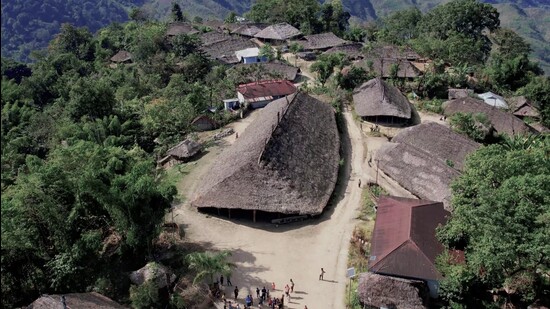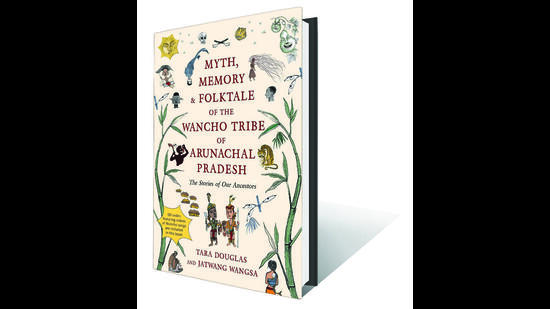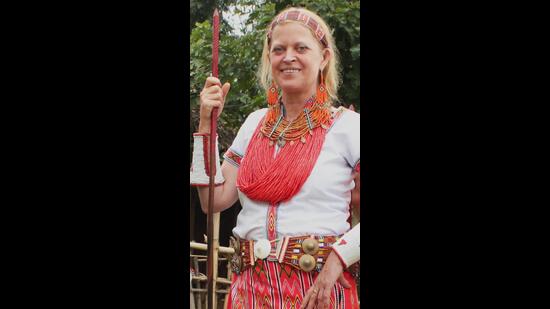Review: Myth, Memory & Folktale of the Wancho Tribe of Arunachal Pradesh by Tara Douglas and Jatwang Wangsa
Stories featuring magical stones, flying foxes and doomed love, among other elements that delight and surprise the reader, reveal the thoughts and value system of the Wancho tribe
This book covers the entire gamut of Wancho mythology, historical and cultural memory, and folktales as promised in the title. The ‘our’ in the subtitle indicates that both writers, Tara Douglas and Jatwang Wangsa see themselves as belonging to the Wancho tribe. Douglas’s introduction makes for an academic, anthropological read that gives an informative peek into the Wanchos, complete with a list of references.

Divided into eight sections including ones entitled Mythological Stories and Just-So Stories, Stories of Migration and War, Of Villages and their Relationships, Doomed Love Stories, Stories of Hunting and Acts of Bravery, Mankind and the Animal World, this volume has beautiful illustrations and QR codes linked to Wancho songs, which add to the reading experience. Some of the illustrations, including the captivating one before The Story of Flying Fox (Loakla), are by Douglas herself. In a nice touch, every story lists the names of the storytellers and the village where it originated.

The longest stories are in the migration section, with one running into 12 pages while there are some that are just a page long. Part creation-myths, part oral history and part moral lessons, these narratives reveal the Wancho thought and value system. Why, for instance, is a certain bamboo not cut? Why is a certain fish not eaten by those from the Dokam Gayam clan? Which gourd fares better? How did the tradition of headhunting begin, why are certain villages at loggerheads? Why is the python not poisonous while the cobra is? The stories address questions like these while stressing the importance of the natural world, and serving to remind readers and listeners that nature will turn dangerous if you don’t try to understand it or lean into its rhythms.
The introduction also notes changes in practised religion: ‘They originate from the period of Wancho life that preceded the arrival of Christianity in that area. The Wanchos themselves comprehended Christianity as a means of achieving progress in their standard of living…’ The impact of Christianity is recorded in A Story of a Tiger and Mankind where, at the end, the storyteller records, ‘The descendants of the Ganam family still live here in Kamhua Noknu and before the advent of Christianity, this family would stay awake all night and perform rituals whenever a tiger was hunted and killed. However, this situation has now changed. Christianity forbids these practices and anyway there are no more tigers left to hunt.’

The translation, which seems to hew too closely to the original, could have been tighter. In terms of craft, however, these stories delight in the way they surprise the reader, which is possibly because they are steeped in the oral tradition. In some, there is the breaking of the narratorial wall when a storyteller suddenly points at a hill or geographical mark and says, ‘There that one’. This happens also in The Story of The Stone, which ends with the ambivalent ‘The stone was certainly magical but there was some confusion because on the one hand we believe that if someone hits the stone, this will bring heavy rainfall. At the same time, we also believe that if the stone is hit, it can bring the dry season and drought to the land.’
Brothers deceive each other in How God Settled on Earth (very Cain and Abel!), family eats family in the Story of the Crocodile (oh, Medea!) and the hero has no qualms about using deceit to win contests in Clever Tortoise. The Love Story from Kaimot and Moctua Villages can give Laila-Majnu a run for their money with the hero beheading the heroine and then singing a song.
All these tales were recorded “on field research visits to several villages in the Upper Wancho region of Longding district, in Arunachal Pradesh: Kamhua Noknu, Khasa, Jagan, Nyinu, Nyisa, Kaimoi and Longkai.’ In the introduction, Douglas also states that the book was written because ‘When the stories are lost, so is the history of the Wancho people, and the sense of security and well being as members of a community that is bound together by the knowledge that sustains it’. She adds that the lore needs “to be preserved for the young generations of Wancho people.”

I was in Ziro in Arunachal Pradesh last year to hold an interactive workshop with undergraduate students. On being asked who they read in Hindi, their second language, they mentioned names such as Premchand or Kabir. None had read any writers from their own state. The poetry they wrote had nothing to do with their own experiences either. After much prodding, one girl in a class of 10, read out a poem that reflected her surroundings. This shows how important it is to disseminate stories like those in this volume.
Hopefully, not just young Wanchos but others too read this book – not to tick any boxes or to understand a culture that most only associate with head-hunting – but for the reason that we read all fiction – to gain a perspective and for delight.
Priyanka Sarkar is an editor, translator and writer.





